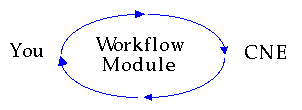
Workflow Systems
Workflow systems can be described according to the type of process they are designed to deal with. Thus we define three types of workflow systems:
- Image-based Workflow Systems are designed to automate the flow of paper through an organization, by transfering the paper to digital "images". These were the first workflow systems that gained wide acceptance. These systems are closely associated with "imaging" technology, and empathize the routing and processing of digitized images.
- Form-based Workflow Systems are designed to intelligently route forms thoughout an organization. These forms, unlike images, are text-based and consist of editable fields. Forms are automatically routed according to the information entered on the form. In addition, these form-based systems can notify or remind people when action is due. This can provide a higher level of capability than image-based workflow systems.
- Coordination-based Workflow Systems are designed to facilitate the completion of work by providing a framework for coordination of action. The framework is aimed to address the domain of human concerns (business processes), rather than the optimization of information or material processes. Such systems have the potential to improve organizational productivity by addressing the issues necessary for customer satisfaction, rather than automating proceedures that are not closely related to customer satisfaction.
Back to the Workflow Module Map

MRH
8/30/94

